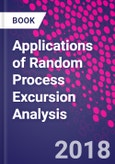This book addresses one of the key problems in signal processing, the problem of identifying statistical properties of excursions in a random process in order to simplify the theoretical analysis and make it suitable for engineering applications. Precise and approximate formulas are explained, which are relatively simple and can be used for engineering applications such as the design of devices which can overcome the high initial uncertainty of the self-training period. The information presented in the monograph can be used to implement adaptive signal processing devices capable of detecting or recognizing the wanted signals (with a priori unknown statistical properties) against the background noise. The applications presented can be used in a wide range of fields including medicine, radiolocation, telecommunications, surface quality control (flaw detection), image recognition, thermal noise analysis for the design of semiconductors, and calculation of excessive load in mechanics.
Table of Contents
Preface
Introduction
Chapter 1 Probability characteristics of random process excursions
Chapter 2 Study of integral parameters of excursions
Chapter 3 Estimation of distribution densities of excursion durations for random stationary broadband signals
Chapter 4 Estimating certain informative parameters of random process excursions above a given level
Chapter 5 Using a family of correlation functions of a clipped random process to increase the accuracy of level crossing parameters estimation
Chapter 6 Estimates obtained through the study of certain less known parameters of excursions in differentiable random processes
Chapter 7 Design methodology of adaptable analyzers used to measure characteristics of excursions in stationary random processes








